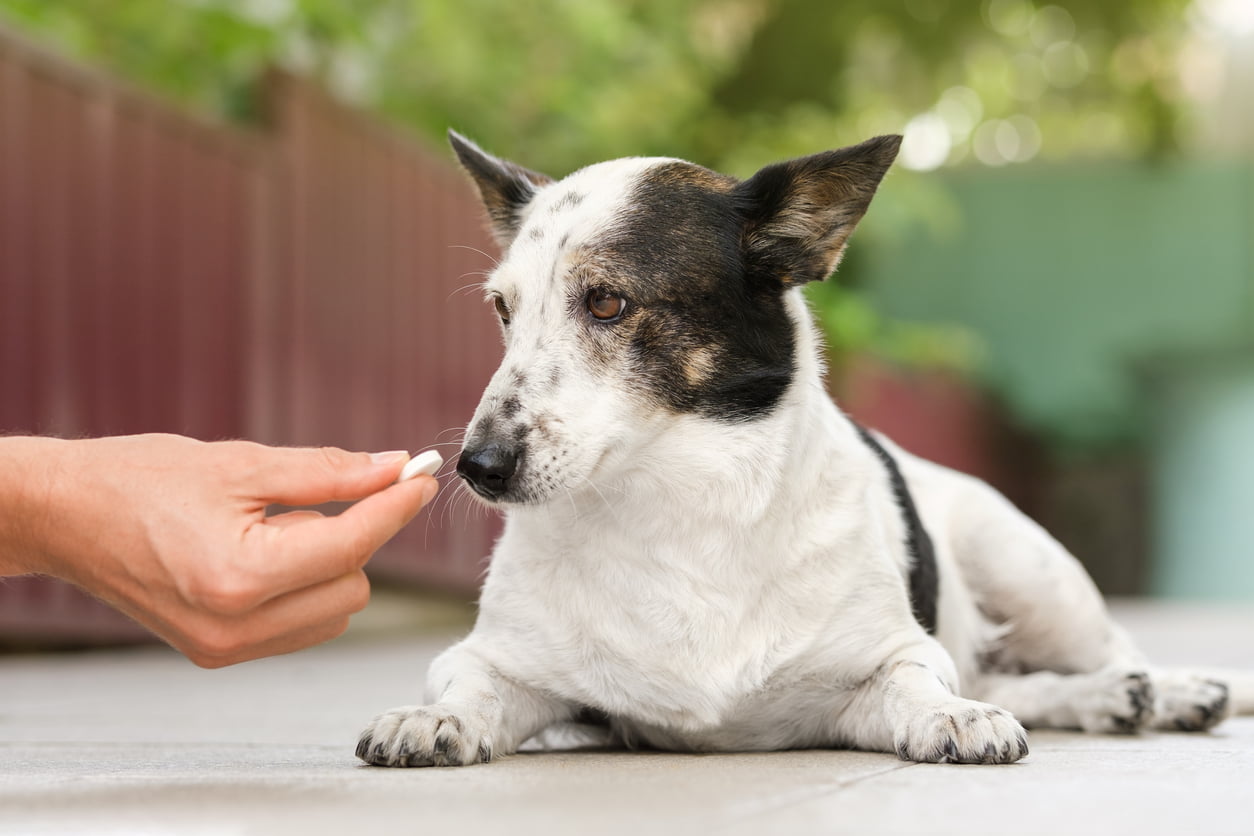Joint pain doesn’t have to define your senior dog’s life. Simple, effective methods to manage joint pain in senior dogs are within reach. This article lays out clear, vet-endorsed steps to address joint pain, aiming to make your senior dog’s daily routine less painful and more rewarding.
Key Takeaways
- Early detection and professional consultation are crucial for managing arthritis in senior dogs, enabling a joint effort to explore treatment options like medication, supplements, and supportive measures.
- Keeping an arthritic dog at a healthy weight is essential to alleviate joint stress; a balanced diet and moderate exercise tailored to their condition can improve their comfort and mobility.
- For optimal care, a multifaceted approach to arthritis in senior dogs, including custom exercise regimens, appropriate nutrition, pain relief medications, home modifications, and alternative therapies, is advised.
Understanding Arthritis in Senior Dogs

Arthritis, also known as degenerative joint disease, is not uncommon in older dogs. As the dog ages, the protective cartilage that cushions their joints starts to break down, leading to bone grinding and causing pain, stiffness, and difficulty in mobility. Recognizing the early signs of a dog’s arthritis, such as reluctance to walk or climb stairs, limping, or difficulty rising from a resting position, can be the first step toward effective management.
When you suspect arthritis in your dog, contacting their veterinarian becomes imperative. They can conduct a comprehensive physical examination, discuss symptoms with you, and if necessary, perform radiographs to confirm the presence of the disease. Consulting a professional ensures that any at-home arthritis management is safe and appropriate for your senior dog.
A collaborative effort between you and your veterinarian is essential in managing arthritis in a senior dog. Together, you can explore various treatment options like medications, supplements, and other supportive measures to manage your dog’s pain and improve their mobility. Understanding arthritis is the first step towards providing the best senior dog care possible.
Connect with a verified veterinarian in minutes. No waiting for appointments or office hours. No high fees. Your pet's health made convenient and worry-free.
Maintaining a Healthy Weight for Arthritic Dogs
Especially for dogs suffering from arthritis, it’s paramount to keep them at a healthy weight as part of senior dog care. Excess weight can increase joint stress and aggravate arthritis pain, whereas a healthy weight can improve mobility and reduce discomfort. So, how can you help your dog maintain a healthy weight?
The first step is to determine whether your dog is overweight. Consult with your veterinarian and calculate your dog’s canine body condition score. If your dog needs to lose weight, it’s important to do so gradually. To help your dog lose weight, weight loss should not exceed 2% of their body weight per week to prevent potential health risks.
As for diet, avoid restricting food intake too drastically. Instead, opt for a balanced diet that supports weight loss without compromising nutrition. Remember, a proper diet can help alleviate the discomfort a dog experiences bone grinding due to arthritis.
Another important element of weight management is exercise. While it’s important to avoid high-impact exercises that could harm an arthritic dog, moderate and gentle exercise can help maintain muscle mass and support joint health. Always consult with your veterinarian before starting any new exercise regimen for your dog.
Customized Exercise Regimens for Senior Dogs

Regular exercise is instrumental in managing arthritis in senior dogs. Regular, low-impact activities can help maintain muscle mass, provide stability to the joints, and improve overall mobility. But what types of exercises are suitable for arthritic dogs?
Swimming and warm water hydrotherapy are excellent low-impact exercises for senior dogs with arthritis. These activities can:
- Increase mobility
- Improve circulation to damaged tissues
- Reduce inflammation
- Loosen stiff muscles
Without placing undue stress on the joints, particularly the neck or shoulder joints.
Despite the importance of exercise, high-impact activities and sporadic, intense sessions, often referred to as the ‘weekend warrior’ model, should be avoided. These can stress the joints and potentially lead to injury. Instead, consider dog arthritis home remedies such as low-impact exercises and appropriate supplements.
Physical therapy can also be beneficial for senior dogs with arthritis. It can help reduce pain, enhance mobility, and increase strength. During therapy sessions, tools such as cones and balance discs may be used to further improve these benefits.
Nutritional Support for Joint Health

Proper nutrition is a key factor in managing arthritis in senior dogs. A diet that supports joint health can have a significant impact on their comfort and mobility. But what does a diet that supports joint health look like?
Prescription diets, available through veterinarians, can be particularly beneficial for dogs with arthritis. These diets typically include natural anti-inflammatory agents, antioxidants, and Omega fatty acids, all of which can help alleviate arthritis symptoms.
In addition to diet, supplements can also support joint health. Consider supplements containing glucosamine and chondroitin, the building blocks of healthy cartilage. These have been shown to have beneficial effects on arthritis pain. Other supplements, like New Zealand green-lipped mussels and deer velvet found in Dr. Buzby’s Encore Mobility, can also be advantageous.
Beyond diet and supplements, medications like anti-inflammatory drugs can be effective in relieving dog’s arthritis pain. Incorporating Omega 3 fish oil into their diet can also help slow down the progression of the disease and aid in managing discomfort.
Pain Relief and Medication Options
Effective pain relief is an essential part of managing arthritis in senior dogs. Several medication options can help manage the pain and improve the quality of life for your furry friend. Some commonly prescribed medications for managing arthritis pain in dogs include:
- NSAIDs (nonsteroidal anti-inflammatory drugs)
- Steroids
- Opioids
- Joint supplements
It’s important to consult with your veterinarian to determine the best pain relief option for your dog’s pain.
In recent years, CBD oil has also gained popularity among dog owners as a natural remedy for arthritis pain. CBD oil, derived from cannabis and hemp, is sometimes used to alleviate arthritis discomfort, though scientific evidence regarding its effectiveness is currently limited.
However, you should be aware that the use of CBD oil for arthritis in dogs is subject to limited regulation. This makes it challenging for veterinarians to endorse its use. The purity, concentration, efficacy, potential benefits, and side effects of CBD oil cannot be reliably predicted due to the lack of scientific evidence.
Therefore, it’s always advisable to consult with your veterinarian before starting any new medication or supplement for your dog. They can provide guidance based on your dog’s specific needs and health status.
Orthopedic Beds and Home Modifications

Making some changes to your home environment can also help ease your senior dog’s arthritis pain. For instance, orthopedic or memory foam dog beds can provide superior comfort and alleviate joint pain for your older dog. These beds can also prevent injury by reducing the need for your dog to jump on and off furniture, further minimizing your senior dog’s arthritis pain.
If you’re introducing a new orthopedic bed, there are a few strategies that can encourage your dog to use it. Try placing the bed in a common area, or next to your bed for nighttime rest. Beds with features such as memory foam and self-warming design can also be more appealing to your dog.
If you’re looking for an orthopedic bed to buy for your dog, the Bedsure Orthopedic Bed is a great choice. It is one of the top-selling dog orthopedic beds sold on Amazon!
In addition to orthopedic beds, other home modifications can help make your home more comfortable and accessible for an arthritic dog. Consider installing dog ramps or steps and using non-slip surfaces. These modifications can aid your dog’s mobility and reduce discomfort.
Remember, even small changes can make a big difference to your dog’s comfort and mobility. Always consider your dog’s specific needs and consult with your veterinarian for further guidance.
Alternative Therapies for Arthritis Management

In addition to traditional treatments, alternative therapies can also help manage arthritis pain and improve mobility in senior dogs. Laser therapy, for instance, is known to reduce pain, muscle spasms, and inflammation. It has shown significant improvement in 85% of dogs treated with this method.
Laser therapy works by reducing inflammation in tendons and ligaments, leading to an enhanced joint range of motion. This can help dogs with arthritis move more freely.
Beyond laser therapy, other alternative therapies can also provide benefits. Techniques like acupuncture and dog massage can alleviate pain and inflammation and address soft tissue imbalances and trigger points.
Remember, every dog is unique, and what works for one may not work for another. It’s always best to discuss these alternative therapies with your veterinarian to determine the most suitable treatment for your dog.
Consult Your Veterinarian for a Personalized Plan
It’s worth noting that there’s no universal solution for managing arthritis in your senior dog. Consulting your veterinarian to develop a tailored plan that considers your dog’s:
- weight
- joint health
- age-related changes
- specific needs for pain management, nutrition, and exercise are essential.
A comprehensive physical exam, palpation of joints to identify areas of pain and tests such as X-rays and blood tests are used by veterinarians to confirm the condition and rule out other diseases.
The veterinarian may suggest a range of treatments, such as:
- pain medications
- alternative therapies
- holistic treatments
- supplements
Each of these treatments can offer unique benefits and can be tailored to your dog’s specific needs and condition.
Remember, the goal is to improve your dog’s quality of life and mobility. Working closely with your veterinarian ensures that your dog gets the most appropriate and effective care.
Summary
Arthritis is a common ailment in senior dogs, but it doesn’t have to mean a life of pain and limited mobility for your furry friend. With a better understanding of the disease, appropriate diet and exercise, pain relief options, and home modifications, you can help manage your dog’s arthritis and keep them comfortable. Remember to consult your veterinarian for a tailored plan that best meets your dog’s needs. Together, we can ensure our senior dogs enjoy their golden years in comfort and happiness.
Frequently Asked Questions
Should you walk an elderly dog with arthritis?
Yes, you should walk an elderly dog with arthritis to maintain their range of motion and joint lubrication. Short, gentle walks are recommended to keep them moving.
What is the last stage of arthritis in dogs?
The last stage of arthritis in dogs is characterized by atrophied muscles and a restricted range of motion in the shoulders, hips, elbows, and spine. It refers to decreased muscle tissue size as they degenerate.
How can I help my overweight dog lose weight safely?
To help your overweight dog lose weight safely, consult with your veterinarian for a proper diet and exercise plan to ensure their weight loss does not exceed 2% of their body weight per week.
Should I consult a veterinarian for managing my dog’s arthritis?
Yes, consulting a veterinarian is important for managing your dog’s arthritis because they can provide a personalized plan with treatments, therapies, and home care strategies tailored to their specific needs.

